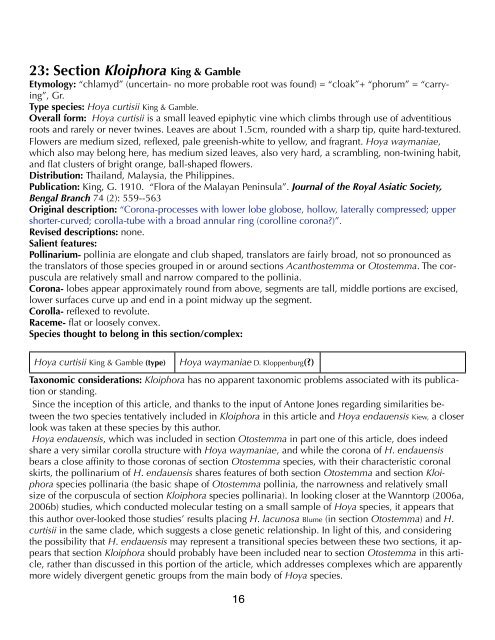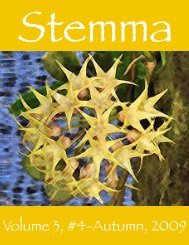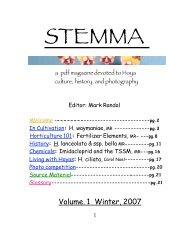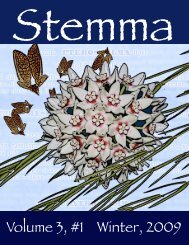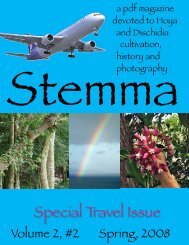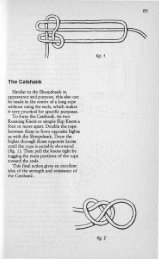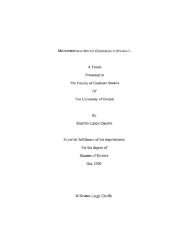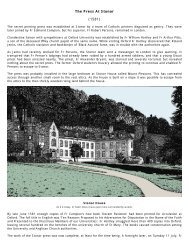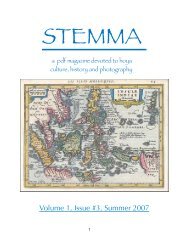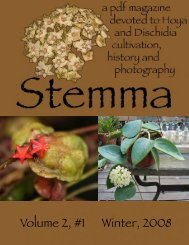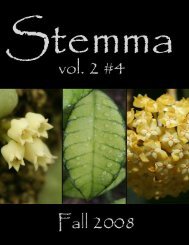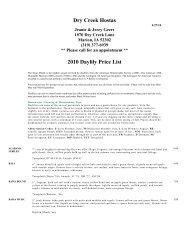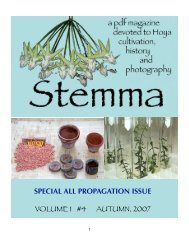Volume 3, Issue #2 - Cubits
Volume 3, Issue #2 - Cubits
Volume 3, Issue #2 - Cubits
Create successful ePaper yourself
Turn your PDF publications into a flip-book with our unique Google optimized e-Paper software.
23: Section Kloiphora King & Gamble<br />
Etymology: “chlamyd” (uncertain- no more probable root was found) = “cloak”+ “phorum” = “carrying”,<br />
Gr.<br />
Type species: Hoya curtisii King & Gamble.<br />
Overall form: Hoya curtisii is a small leaved epiphytic vine which climbs through use of adventitious<br />
roots and rarely or never twines. Leaves are about 1.5cm, rounded with a sharp tip, quite hard-textured.<br />
Flowers are medium sized, reflexed, pale greenish-white to yellow, and fragrant. Hoya waymaniae,<br />
which also may belong here, has medium sized leaves, also very hard, a scrambling, non-twining habit,<br />
and flat clusters of bright orange, ball-shaped flowers.<br />
Distribution: Thailand, Malaysia, the Philippines.<br />
Publication: King, G. 1910. “Flora of the Malayan Peninsula”. Journal of the Royal Asiatic Society,<br />
Bengal Branch 74 (2): 559--563<br />
Original description: “Corona-processes with lower lobe globose, hollow, laterally compressed; upper<br />
shorter-curved; corolla-tube with a broad annular ring (corolline corona?)”.<br />
Revised descriptions: none.<br />
Salient features:<br />
Pollinarium- pollinia are elongate and club shaped, translators are fairly broad, not so pronounced as<br />
the translators of those species grouped in or around sections Acanthostemma or Otostemma. The corpuscula<br />
are relatively small and narrow compared to the pollinia.<br />
Corona- lobes appear approximately round from above, segments are tall, middle portions are excised,<br />
lower surfaces curve up and end in a point midway up the segment.<br />
Corolla- reflexed to revolute.<br />
Raceme- flat or loosely convex.<br />
Species thought to belong in this section/complex:<br />
Hoya curtisii King & Gamble (type) Hoya waymaniae D. Kloppenburg(?)<br />
Taxonomic considerations: Kloiphora has no apparent taxonomic problems associated with its publication<br />
or standing.<br />
Since the inception of this article, and thanks to the input of Antone Jones regarding similarities between<br />
the two species tentatively included in Kloiphora in this article and Hoya endauensis Kiew, a closer<br />
look was taken at these species by this author.<br />
Hoya endauensis, which was included in section Otostemma in part one of this article, does indeed<br />
share a very similar corolla structure with Hoya waymaniae, and while the corona of H. endauensis<br />
bears a close affinity to those coronas of section Otostemma species, with their characteristic coronal<br />
skirts, the pollinarium of H. endauensis shares features of both section Otostemma and section Kloiphora<br />
species pollinaria (the basic shape of Otostemma pollinia, the narrowness and relatively small<br />
size of the corpuscula of section Kloiphora species pollinaria). In looking closer at the Wanntorp (2006a,<br />
2006b) studies, which conducted molecular testing on a small sample of Hoya species, it appears that<br />
this author over-looked those studies’ results placing H. lacunosa Blume (in section Otostemma) and H.<br />
curtisii in the same clade, which suggests a close genetic relationship. In light of this, and considering<br />
the possibility that H. endauensis may represent a transitional species between these two sections, it appears<br />
that section Kloiphora should probably have been included near to section Otostemma in this article,<br />
rather than discussed in this portion of the article, which addresses complexes which are apparently<br />
more widely divergent genetic groups from the main body of Hoya species.<br />
16


